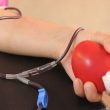Courtesy of Dr. Carlos Fava. One of the characteristics of chronic total occlusion (CTO) is the use of two access routes: femoral and radial. The radial approach is safer, but it has not been thoroughly analyzed in this type of PCI. The study looked at 3709 patients undergoing left main percutaneous coronary intervention (PCI) for...
Radial Access Is Always Preferred, Even for Treatment of the Left Main Coronary Artery
The potential need for a 7-Fr guidewire, the use of several coronary guidewires and/or a kissing balloon, and the requirement of indispensable monitoring by intravascular ultrasound (IVUS) have been used by some interventional cardiologists as excuses to resist radial access. In that sense, left main coronary artery angioplasty was the last stand of femoral access....
Less Bivalirudin and Minimal Use of Ultrasound for Puncture Is the Worldwide Trend in Transradial Access
A worldwide survey shows there is much room for improvement as regards transradial access procedures, particularly for the prevention of radial artery occlusion post-procedure. While in many places this has been a standard technique for some time now, other places are yet to evolve, and that is the result of this survey. In the past...
ESC 2018 | MATRIX: 1-Year Superiority of Transradial Access
Transradial access should be the access of choice in patients with acute coronary syndrome, while bivalirudin has not shown any benefit for this population. The long-term follow-up from the MATRIX (Minimizing Adverse Hemorrhagic Events by Transradial Access Site and Systemic Implementation of Angiox) trial confirms the results at 30 days: transradial access is here to stay...
Important Study Suggests that Rotational Atherectomy Is Feasible with Transradial Access
Rotational atherectomy is a very important tool in the treatment of heavily calcified and non-dilatable lesions. Historically, transfemoral access has been the gold standard due to a perceived need for large-bore guidewire catheters in order to use spheroids for proper debulking. Nowadays, rotational atherectomy has evolved towards a technique that aims to modify plaque for...
Transradial Access and Early Discharge in Percutaneous Interventions
Transradial Access and Early Discharge in Percutaneous Interventions. Presenters: Dr. Jorge Mayol, Uruguay. Dr. Anibal Damonte, Argentina. This video, sponsored and funded by Medtronic, was filmed during SOLACI-CACI 2017 Congress, at Hilton Buenos Aires Hotel (in Argentina). Do you want to take a look at all other SOLACI-CACI 2017 Congress Medtronic cases? Watch them We are interested in your...
Transradial access shows no benefit of bivalirudin
The aim of this study was to compare bivalirudin against heparin in patients with ST elevation acute myocardial infarction undergoing transradial primary PCI. Both bivalirudin and the transradial access are strategies aimed at reducing bleeding complications in patients undergoing acute MI. However, the benefit of their combined use is not year clear. Even though...
Right vs. Left Transradial Access for Coronary Procedures
Courtesy of Dr. Guillermo Migliaro. Coronary angiography and angioplasty via transradial approach are associated with a significant reduction in access site complications, compared with transfemoral and transbrachial access. Moreover, a significant reduction in mortality has been reported for procedures performed via transradial approach vs. transfemoral approach in primary angioplasty. There is a limited number...
How to Make Radial Access Even Safer with Minimum Effort
Courtesy of Dr. Agustín Vecchia. Since 1990, radial access has progressively gained ground, currently becoming the default technique in most endovascular intervention centers. One of its few associated complications is radial artery occlusion. While most frequently clinically silent and non-serious, this complication could hinder the performance of future procedures in the patient and, in some...
MATRIX: The radial access reduces events, bivalirudin with mixed results
Two separate works are part of the MATRIX study investigating strategies to reduce bleeding and mortality in patients with acute coronary syndrome. The first part of the work that was simultaneously published in The Lancet found a significant reduction in major bleeding and mortality in patients undergoing coronary angiography and angioplasty using radial versus femoral...








